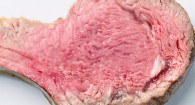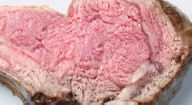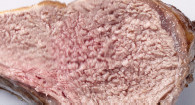100% Natural -100% Delicious
If you're concerned about the quality and safety of the food you eat, (and who isn't these days?) New Zealand Spring Lamb and Australian Opal Valley Lamb are your most delicious and nutritious choices
One hundred percent additive free, our lamb is raised in the rolling hills of New Zealand and Australia, the all-natural way. That means not only does it taste good, but it's also good for you.
Pollution-free and nuclear free, New Zealand and Australia remain virtually untouched by environmental problems. With abundant fresh clean water supplies and a temperate climate, it offers the ideal environment for producing top quality, flavorful meat.
New Zealand and Australian regulations do not permit the use of growth promoting hormones or additives. Additionally, drugs such as antibiotics are not administered to lambs because they are raised year round in outdoor pastures.
New Zealand Spring Lamb and Australian Opal Valley Lamb are 100% all-natural, tender and nutritious.
A Healthy Food For Healty Eating
Easily digestible and packed with goodness and nutrients, New Zealand Spring Lamb and Australian Opal Valley Lamb are low in cholesterol, fat and calories, and is an ideal ingredient in a well-balanced diet.
A cooked 100 g fat trimmed portion of lamb provides:
- At least 25% of protein RDA
- All essential amino acids
- Less than 6.0 g saturated fat and 0.4 g polyunsaturated fat
- Less than 50 mg of cholesterol
- Approximately 220 kcal of energy
- A rich supply of B vitamins particularly B12 and niacin
- A good supply of iron and zinc
How To Store, Thaw, And Cook
To Store:
Frozen lamb may be kept safe and flavorful for six to nine months. If the original wrap is intact, simply place in your freezer. If the wrap is broken, rewrap the lamb in plastic wrap or place in a large plastic freezer bag.
To Thaw:
To obtain the best possible results, lamb should be allowed to thaw completely before cooking.
1. Allow 4 to 6 hours per pound for thawing unwrapped lamb roasts in the refrigerator. Boneless cuts and chops will require less time.
2. Allow 2 to 3 hours per pound for thawing wrapped lamb at room temperature.
Cooking Tips:
Don't overcook lamb roasts, chops, loins or tenderloins. Lamb is most delicious when served medium rare to medium in doneness.
- Always serve lamb piping hot or completely cold.
- Marinate cuts to enhance lamb's mild flavour.
- Stuffings, glazes, and sauces add interesting variety to all cuts of lamb.
- Lamb can be cooked from a frozen state; simply increase the cooking time by one-fourth to one third. Be sure to check for doneness using a meat thermometer.
Cooking Guide:

- Rare
- TEMP
- 120-130 ℉
- APPERANCE
- Very red, very moist with warm juices
- COOK
- 20-25 min/lb at 360 ℉
- REST
- 8-10 min
- FEEL
- Soft

- Medium Rare
- TEMP
- 130-140 ℉
- APPERANCE
- Light red, very moist with warm juices
- COOK
- 25-30 min/lb at 360 ℉
- REST
- 8-10 min
- FEEL
- Soft, slightly spongy and springy

- Medium
- TEMP
- 140-150℉
- APPERANCE
- Pink red color, moist with clear pink juices
- COOK
- 30-35 min/lb at 360 ℉
- REST
- 8-10 min
- FEEL
- Slightly firm and springy

- Well-done
- TEMP
- 150-160℉
- APPERANCE
- No pink or red, slightly moist with clear juices
- COOK
- 35-40 min/lb at 360 ℉
- REST
- 8-10 min
- FEEL
- Firm
Freezing Cooked Dishes:
Casseroles and meat pies can be frozen for future use. Make double quantities, chill half in the refrigerator in an oven-safe or foil container. Cover, allowing 1/2 inch at the top for expansion, and store in the freezer. Potato or dumpling garnishes should be added fresh at the time of reheating. Allow enough time to completely heat through to the center. To see if thoroughly heated, pierce with a fork.
Preparing Lamb
There five most popular cuts of lamb are: lamb shoulders, frenched racks, shanks, loins, and legs. Most lamb is sold in supermarkets with fat layer trimmed to 1/4 or 1/8 inch. You can trim this thin layer of remaining fat from the meat before or after cooking. (Some cooks choose to leave this layer on for additional flavor.)
Fresh Lamb
Fresh lamb should be stored in the refrigerator or frozen immediately after purchasing.
Refrigrate
Refrigerate fresh lamb at 40°F or below immediately after purchasing. Ground lamb or stew meat should be used within 1 to 2 days. Lamb chops, roasts, and steaks should be used within 3 to 5 days. Fresh lamb can also be frozen immediately at 0°F or below.
Freeze
Refrigerate fresh lamb at 40°F (4°C) or below immediately after purchasing. Ground lamb or stew meat should be used within 1 to 2 days. Lamb chops, roasts, and steaks should be used within 3 to 5 days. Fresh lamb can also be frozen immediately at 30°F (0°C) or below.
Frozen Lamb
There are three ways to thaw frozen lamb safely: in the refrigerator, in cold water, and in the microwave.
In the refrigerator
Once frozen lamb has thawed in the refrigerator, roasts, steaks, and chops can be stored safely in the refrigerator for 3 to 5 days and ground lamb for 1 to 2 days. If you decide not to use it during this time period, you may refreeze lamb without cooking it first.
In Cold Water
When thawing in cold water, leave frozen lamb in its packaging, making sure it is air tight. If not, transfer it to a leak-proof bag. Keep the lamb submerged in cold water, changing it every 30 minutes to continue thawing. Plan to cook it immediately. It should not be frozen unless cooked first.
In the Microwave
As with the cold water method, when frozen lamb is thawed in the microwave, it must be cooked immediately. It should not be re-frozen unless cooked first.
Cooked Lamb
Cooked lamb from take-out should be hot when bought. Be sure to use it within 2 hours (or 1 hour if the air temperature is above 90°F (32°C). Otherwise, refrigerate it at 40°F (4°C) or below in a shallow, covered container, and eat within 3 to 4 days cold or reheated to 165°F (144°C). Prepared lamb can also be safely frozen and should be eaten within 2 to 3 months for best quality.
Barbecuing Lamb
New Zealand Spring Lamb and Australian Opal Valley Lamb are tender, succulent meat that lends itself ideally to barbecuing. Although it is lean meat, it has the right amount of marbling for flavorful grilling, without causing problems with flame flare ups. It has enough fat to drip down onto the coals, ceramic briquets or mesquite wood, to provide the necessary smoke for the characteristic barbecue flavor.
Lamb needs little basting or marinating to be tasty and juicy - a light brushing with oil and a sprinkle of herbs or garlic is sufficient. However, lamb combines well with a large variety of flavors and you may wish to try some of our tasty marinade suggestions for your everyday cooking or when you're entertaining.
Barbecuing Tips:
- Always clean, oil and pre-heat grill before cooking to prevent sticking.
- Don't pierce meat with a fork when turning or juices will run out.
- If your glaze or marinade has a sweet base, add only in the last few minutes of grilling.
- If marinating at room temperature, an hour or two is sufficient, otherwise marinate meat in the refrigerator overnight.
- Brush salad oil on lamb for a tasty, quick glaze.
- Have all marinades, sauces and equipment like brushes and tongs on hand before you start cooking.
- Bring meat to room temperature before grilling.
- Trim off excess fat to prevent flare ups.
- Lightly score fat on outside of chops to prevent curling.
- For even cooking, make sure kabobs are the same size and chops are the same thickness.
- Soak wooden skewers in water before using.
- If alternating vegetable chunks with lamb cubes on skewers, make sure the vegetables require the same cooking time as the lamb.
- Tasty lamb sausages can be served on buns or used for kabobs.
- If barbecuing a whole or three-quarter leg on a spit, be sure the spit is well balanced.
- The boneless shoulder and butterflied leg cuts are good for kabobs.
- Shoulder chops should be marinated a little longer than loin chops.
- Boneless loins and racks are elegant cuts for barbecues.
Barbecue Time Guide
Times are only approximate because many variables can affect cooking: type of barbecue and fuel, location of grill, temperature of food and air, wind conditions, etc.
Check lamb often to avoid overcooking. Most cuts will be juicier and more flavorful if cooked to medium-rare, while some products like sausages should be fully cooked before consuming. For steaks, chops, and roasts, the lamb should be nicely seared on the outside, but pink and juicy inside.
- SAUSAGES: Medium- - 6 minutes turning frequently. Well-done - 8 minutes turning frequently
- LEG STEAKS: 3/4" thick Rare 3-4 minutes each side, Medium 4-5 minutes each side
- LOIN CHOPS: 1" thick Rare 4-5 minutes each side Medium 8 minutes each side
- SHOULDER CHOPS: 3/4" Rare 5-6 minutes each side, Thick Medium 8 minutes each side
- BONELESS (Butterflied) LEGS: Rare 20-25 minutes, Medium 30-35 minutes
- LEGS, BONE IN: Rare 20 minutes per lb., Medium 25 minutes per lb. RACKS: Rare 15-20 minutes, Medium 20-25 minutes
- KABOBS: Medium, Rare 7-10 minutes
Note: Above times assume average distance of 4" from hot coals, using room temperature thawed meat.
Tips For Calorie - Wise Cooking
Since lamb is easily digestible and has a low saturated fat content (4.2g/1000 gram serving) it is ideal for weight control diets and low cholesterol diets.
Other ways to minimize calories and maximize nutrition depend on the cooking method - braising, broiling, stir frying and microwaving are the most calorie efficient methods. The selection and preparation of foods should contain limited amounts of fat, sugar and salt. Trim meat of all visible fat; always roast on a rack to let the fat drip off; use herbs such as dill, rosemary, thyme, and other seasonings like garlic for added flavor without added calories or salt.
Microwaving Lamb
Microwave cooking of meats retains juices and flavor. To ensure a crispy crust, (because some microwave ovens do not produce one), we suggest pre-roasting your lamb in the microwave oven and finishing in a conventional oven. Alternatively, browning agents, soy sauce or teriyaki sauce can be brushed over the surface of the meat before placing in the microwave oven. Lamb should be completely thawed before microwaving. To roast lamb, consult the cookbook accompanying your microwave unit for roasting times. Roast lamb uncovered on a microwave roasting rack. Set the rack in a shallow glass baking dish and turn according to directions to make certain meat cooks evenly. Roast to 150°F-165°F (66°C-74°C). A meat thermometer is the most accurate test for doneness. Leave roast foil-wrapped to rest in a warm place, to set the juices and complete cooking. The temperature will continue to rise 10°F-15°F (6°C-9°C) further. Lamb chops should be cooked uncovered to medium rare doneness. A browning pan will yield a crisper surface.





